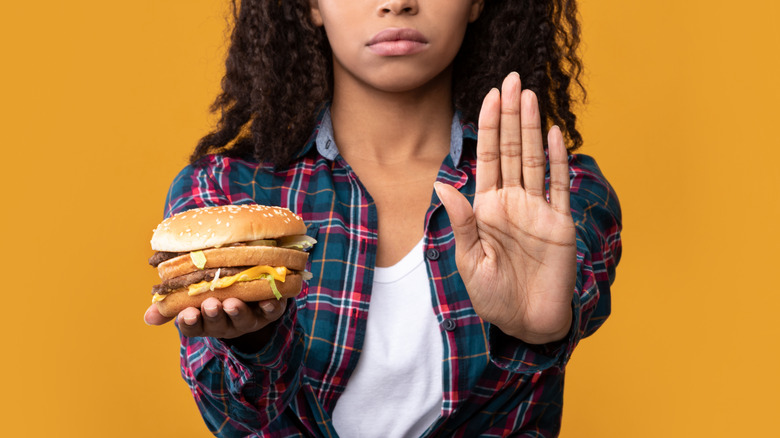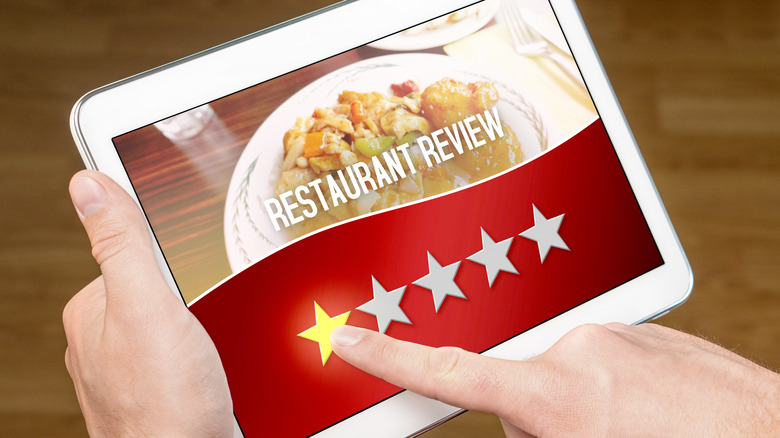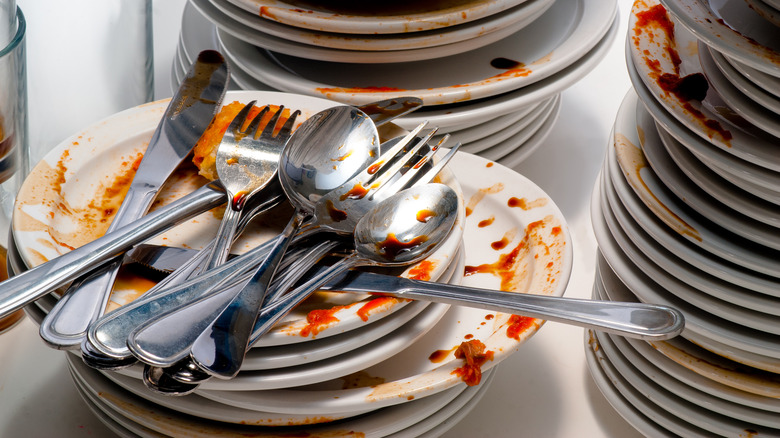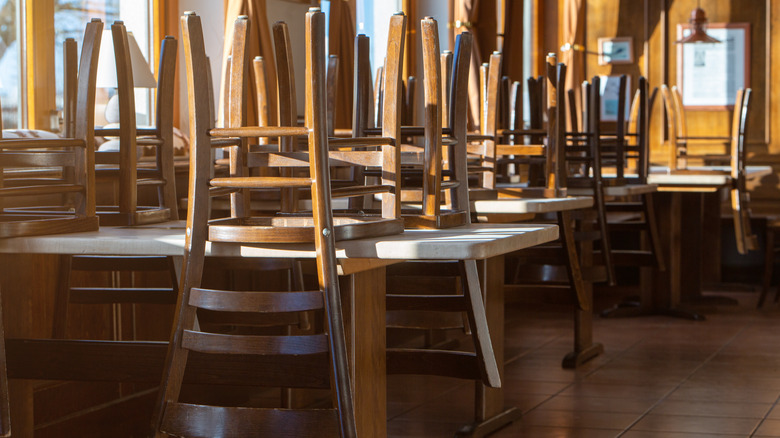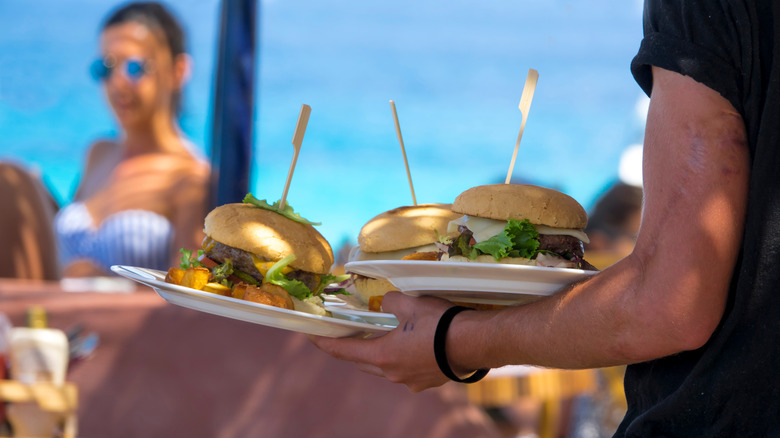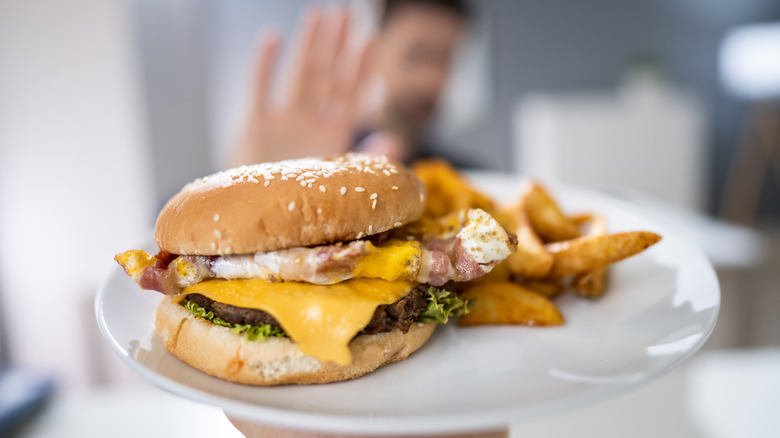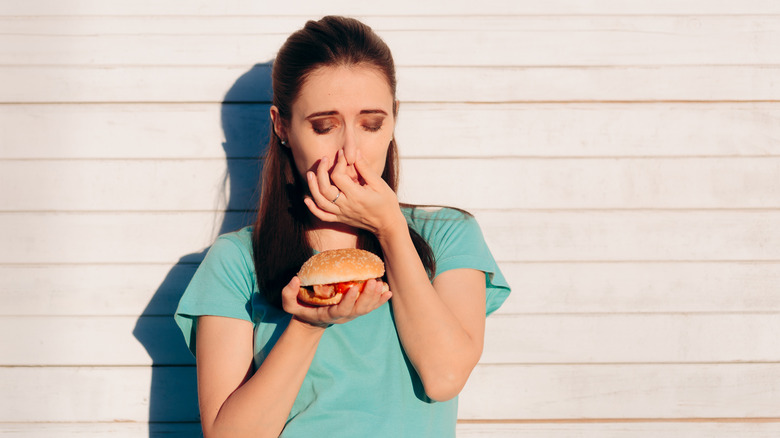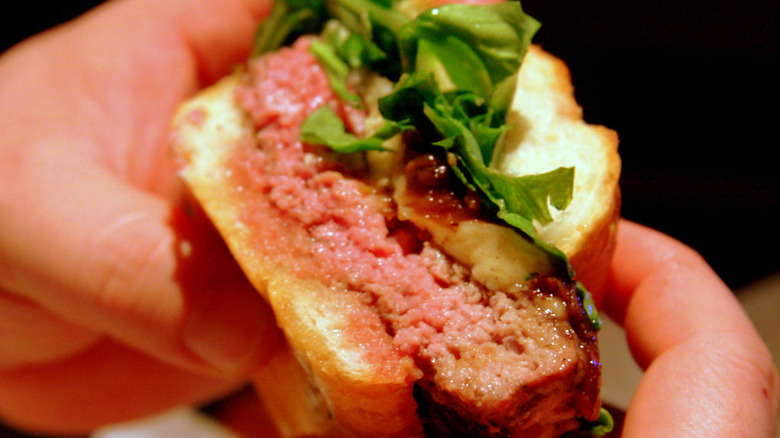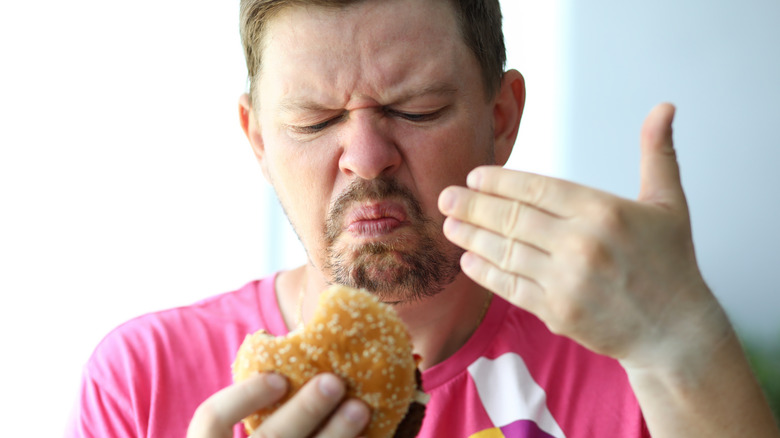Here's How You Can Tell A Restaurant Has Bad Burgers
There's really nothing more heart wrenching than biting into a subpar burger at a seemingly nice restaurant and shocking your voracious taste buds with despair. You were envisioning a juicy patty, cooked to perfection, delicately topped with all the key condiments, sandwiched in between two buttery buns. But instead, you were served something flimsy and flavorless, leaving you no choice but to flee the scene, go home and microwave a pathetic cup of instant noodles.
Bland restaurant burgers can transport you back to the dreaded cafeteria room, pronto. Whether they're far too small, messy, or simply lackluster, this type of all-too-common conundrum is something we want to avoid entirely, even before stepping foot into a restaurant. Yes, it's true. You can sniff out foul play even before strolling into a burger joint. If you're curious how this is possible, please — don't fret. We've assembled a candid list of red flags to help you detect when a restaurant has bad burgers.
The online reviews are shady
Preventative measures are mandatory — that starts with doing a bit of dirty detective work. Read online reviews. If you get that 'pit in your stomach' feeling after filtering through comments, then just don't go to the restaurant. Easier said than done? Yes. If you have your heart set on a specific eatery, we suggest taking a deep dive into at least two credible restaurant review sites, but keep hyper focused on the bad burger mission. A plethora of negative sentiments from infuriated customers is a blaring, telltale sign. However, according to Food Network, if one pessimistic comment isn't mirrored by other reviews, it just might be totally innocuous — so you shouldn't trust it immediately.
We're also not only concerned about the burgers here. Are people chattering about the restaurant itself? Sticky tables? Gross crumbs on the floor? Dirty utensils? Just filthy altogether? They might make a decent burger, but was it made in a sanitary environment? Likely not. So just don't go to a restaurant with loads of bad reviews — it'll save you a lot of heartbreak.
The restaurant isn't clean
You've pulled into your burger joint of choice. You're stationed in the parking lot, but it's littered with copious amounts of trash and the front windows are streaky. It may be time to rethink your choice of restaurants. Consultant Ken Rice told Reader's Digest this is a sign that cleanliness isn't too important, and might transfer into the space where your burger is prepared.
Even if the front of the restaurant looks presentable, it may be a good idea to check out the restrooms before you place your order. Are they in need of a good deep cleaning? If so, run fast. Last but not least, if you're handed a filthy menu with smudged ketchup from the night before or find yourself wiping off dirty silverware, this is the last straw and a prominent precursor to a bad burger. No one wants to eat a hamburger that was cooked in a dirty kitchen, and the chances that the kitchen is spotless when the rest of the place is... not spotless, are very slim.
The restaurant is practically vacant
We really want to underscore that a restaurant with minimal occupancy is seriously questionable. If you're sitting down to dine around peak lunch and dinner hours and only a few hungry, sad souls surround you, raise a brow. This is a cautionary tale that you don't want to experience. You might even make merciful excuses in your mind to give them the benefit of the doubt but let's face it — a hot restaurant with darn good cuisine is usually swarming with a sizable, ongoing wait list.
Moreover, if you decide to dine at a specialty restaurant (aka burger joint) and no one is there, you'll likely face bad burger trouble. Perry Groups' Restaurant and Hospitality Consultant Dennis P. Gemberling emphasized to Insider that if the masses aren't flocking to a specific restaurant and it's visibly not popular, chances are, you'll share the same cynical sentiments.
So our advice? If it's vacant, do yourself a favor and vamoose right on out of there.
The menu is vast with bad options
You just want a dang good burger, but the plethora of options is hurting your head. If there's a laundry list of several different types of burgers, you might wonder how the kitchen has the bandwidth to prep all of these variations. A minuscule thought bubble pops up and you wonder "how can they truly perfect all of those items while preserving its freshness?"
Well, according to food experts at DailyMail, long menus usually mean that the restaurant is just serving you lousy, frozen ingredients — usually for a pretty penny. A multi-page menu with 100 options should set off an alarm. Shorter, more concise menus with a small handful of select burger options, and perhaps a few appetizers, is what you want. You can also safely infer that the line chefs have spent time perfecting those few entrees on the menu, and the chances of you biting into a junky burger are slim to none.
Your food is delivered alarmingly fast
Tick, tock. Your stomach is vehemently growling but you're willing to wait for the perfect burger. But within approximately six to eight minutes of ordering, your burger is out, ready for you to consume. On the surface, this may seem exciting — but it's actually something you should question.
According to New York Post, a rare burger takes around three minutes per side and medium-rare burger cooks for around four minutes per side. Unless you specifically ordered your burger barely cooked, do yourself a favor and return it to the kitchen. Taking into account the time it took for your waitress to deliver your order to the cook, and the time it took to plate and build the burger, that super fast delivery just isn't possible with a freshly cooked piece of meat. If your burger is served to you within just a few minutes of ordering, we're sorry to break this devastating news, but it was most likely pre-cooked and wistfully waiting on the sidelines for an order to come through.
The presentation is disastrous
The server greets you with a subdued smile and brings out your burger. It's finally here but to your dismay, it looks considerably unappetizing. Presentation absolutely matters before going in for the kill. Can you visibly see the freshly grilled patty with oozing cheddar cheese that's still slightly bubbling? How about the toppings — are they crisp or wilted? Let's not forget the buns either. They should be soft to the touch, sort of like a carb-filled cloud — not stale as your cardboard moving boxes.
According to The Restaurant Times, the way restaurants plate their food is a direct indicator of how experienced the kitchen staff is. A bad presentation not only signals bad tasting food, but it also suggests a mismanaged kitchen and poor quality all around.
So at the end of the day, if your eyes don't like what they see, we suggest sending it back — or packing it to go for your hungry hound dog at home.
The smell is completely repulsive
Something sour is whirling in the air. You remembered to take a shower before dining and you definitely put deodorant on, so it's not you. Could it be the burger sitting right in front of you? Your sniffer can certainly detect a bad burger (and by that, we mean we spoiled burger). If you're served a truly bad burger, everything about it will smell repulsive, pretty much comparable to that dirty laundry pile accumulating by the day.
According to Healthline, you can quickly detect if cooked ground meat is spoiled — it'll definitely give off a distinct, foul odor that will permeate your personal bubble space. The scent might actually transform over time, simply due to an increase in spoilage bacteria. Fresh ground meat won't have much of a smell at all, so if your sniffer starts to talk... you should listen.
Your burger is under-cooked
It's no secret that burger doneness is totally up to your discretion, obviously. But if you order a medium or well-done burger and bite into something particularly pink, the restaurant should be issued a big fat ticket from the burger police. The kitchen staff (especially at a burger joint) should be well-versed in the varying degrees of cooking a burger. It's an implicit rule that any restaurant should comply with your specific request.
It's also pertinent to note — when a restaurant serves super rare burgers, this is classified as risky business that could lead to a pointless day on the couch with food poisoning. The CDC states that ground beef should be cooked to 155 degrees Fahrenheit and a rare burger is cooked to 120 degrees Fahrenheit– a pretty large disparity if you ask us and a total health hazard.
Needless to say, if you receive a burger that isn't cooked the way you requested, it's perfectly okay to send it back to the kitchen or just follow the exit signs.
The toppings are terrible
Of course, most restaurants always offer a suite of toppings and sauces beyond the ketchup, especially if you're at some fancy 'designer' burger restaurant. But proceed with caution. Condiments can substantially sabotage a burger and make a perfectly seasoned patty a tad too sweet, sour, spicy — or all of the above.
According to TheRecipe, there's a slew of tested condiments that just don't jive with burgers. So it's safe to say, any restaurant attempting to serve you a burger with certain despicable toppings is a sign you're in for a rude awakening. For example, brussels sprouts. The bold, nutty flavor can really corrupt everything and usually doesn't pair well with ground beef. How about apple sauce? If you find this as a condiment on the menu, you should just pack your bags immediately. Lastly, if a restaurant attempts to treat your burger like a meatball's close cousin, lathering it in marinara sauce, you'll undoubtedly get served a soggy, sad mess.
What are they trying to hide under all those toppings anyway? We're guessing it's a bad burger.
The bun is bland and wobbly
Ahh, let's not forget about those buns, hun. Along with the actual patty and toppings, a bun can ultimately determine an entire burger's fate. It's certainly the restaurant's responsibility to put quality control measures in place when it comes to the buns. Just think about the last time you ordered a discernibly good burger that checked off all of the boxes. We're assuming the buns were light, soft and airy — perhaps with a subtle touch of sweetness or slightly toasted.
It's also safe to say that a bun's responsibility is to act as the 'burger bodyguard,' maintaining the overall structure, ensuring it doesn't topple over like a ruthless game of Jenga. Sous Chef Carey Dobies at BOKX 109 American Prime told Eater," A lower-quality bun that is highly processed cannot stand up to the fat content of a good burger. Let's say you design a burger that is highly fatty and you pair it with a lower quality bun — you end up with a bun that falls apart, and you wind up eating the burger with a fork."
So, if you're served buns that are stale, frail, unsupportive, or even soggy, this is presumably a bad burger. You might as well go to find a few pieces of crunchy iceberg lettuce to do the job.
